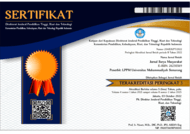Digital Literacy: Implementasi Pelatihan English Speaking Performance pada Santriwati Pondok Pesantren Sahlan Rosyidi
(1) Pendidikan Bahasa Inggris, Universitas Muhammadiyah semarang
(2) Pendidikan Bahasa Inggris, Universitas Muhammadiyah semarang
(3) Pendidikan Bahasa Inggris, Universitas Muhammadiyah semarang
(4) Pendidikan Bahasa Inggris, Universitas Muhammadiyah semarang
(5) Pendidikan Bahasa Inggris, Universitas Muhammadiyah semarang
(6) Pendidikan Bahasa Inggris, Universitas Muhammadiyah semarang
(7) Pendidikan Bahasa Inggris, Universitas Muhammadiyah semarang
(*) Corresponding Author
Abstract
The learning process and life activities during the Covid-19 pandemic proceed through online social media, so there is a need for technological literacy. This activity also happened at the Pondok Pesantren Putri Sahlan Rosyidi Semarang where the academic abilities of the female students, especially the English language, were very diverse but there was still a lack of English-speaking practice programs that were integrated with digital literacy. Initial findings of the daily English-speaking ability of female students had an average of 65 which had to be improved again. Based on this statement, our team focuses on the implementation and training of Digital Literacy through the practice of speaking English for female students at the Pondok Pesantren Putri Sahlan Rosyidi Semarang, consisting 60 female students. The method used is descriptive quantitative by applying brainstorming, group discussion, explanation, speaking practices, digital platform, and evaluation of students' digital understanding of literacy. The results show that the implementation of the practice of speaking English based on digital literacy with an increase in the average speaking English rising to 81. In addition, the female students gave a positive response to the implementation of digital literacy and the practice of speaking that was trained. They were also motivated to practice conversation or monologue by utilizing digital technology.
Keywords
Full Text:
PDFReferences
Cote, T., & Milliner, B. (2018). A Survey of EFL Teachers’ Digital Literacy: A Report from a Japanese University. Teaching English with Technology, 18(4), 71–89. http://www.tewtjournal.org
Gee, J. P. (2003). What video games have to teach us about learning and literacy. Computers in Entertainment, 1(1), 20–20. https://doi.org/10.1145/950566.950595
Leu, D. J., Kinzer, C. K., Coiro, J., Castek, J., & Henry, L. A. (2017). New Literacies: A Dual-Level Theory of the Changing Nature of Literacy, Instruction, and Assessment. Journal of Education, 197(2), 1–18. https://doi.org/10.1177/002205741719700202
Littlejohn, A., Beetham, H., & McGill, L. (2012). Learning at the digital frontier: a review of digital literacies in theory and practice. Journal of Computer Assisted Learning, 28(6), 547–556. https://doi.org/10.1111/j.1365-2729.2011.00474.x
Lotherington, H., & Jenson, J. (2011). Teaching Multimodal and Digital Literacy in L2 Settings: New Literacies, New Basics, New Pedagogies. Annual Review of Applied Linguistics, 31(June), 226–246. https://doi.org/10.1017/S0267190511000110
Peyton, J., Moore, S., & Young, S. (2010). Evidence-based, student-centered instructional practices. Center for Applied Linguistics, April. http://scholar.google.com/scholar?hl=en&btnG=Search&q=intitle:Evidence-Based+,+Student-Centered+Instructional+Practices#1
US Educational Departement, _. (2015). Workforce Innovation and Opportunity Act: Integrating Technology in WIOA. Fact Sheet. U.S. Department of Education Office of Career, Technical, and Adult Education. http://www2.ed.gov/about/offices
Vanek, J. (2014). Open educational resources: New technologies and new ways of learning. MinneTESOL Journal, Fall. http://minnetesoljournal.org/journal-archive/mtj-2014-2/open-educational-resources-new-technologies-and-new-ways-of-learning/
Article Metrics
Abstract view : 419 timesPDF - 135 times
DOI: https://doi.org/10.26714/jsm.4.1.2021.18-28
Refbacks
- There are currently no refbacks.
Copyright (c) 2021 Jurnal Surya Masyarakat

Jurnal Surya Masyarakat (JSM) is licensed under Creative Commons Attribution-NonCommercial-NoDerivatives 4.0
------------------------------------------------------------------------------------------------------------------------
Jurnal Surya Masyarakat (JSM)
p-ISSN: 2623-0364; e-ISSN: 2623-0569
Published by: Lembaga Penelitian dan Pengabdian Masyarakat (LPPM) Universitas Muhammadiyah Semarang



.jpg)







.jpg)